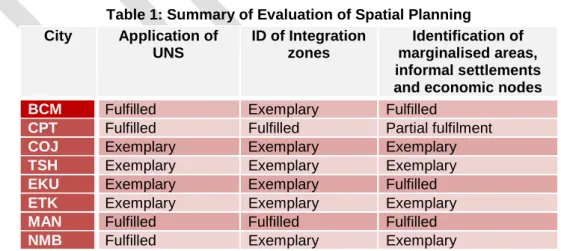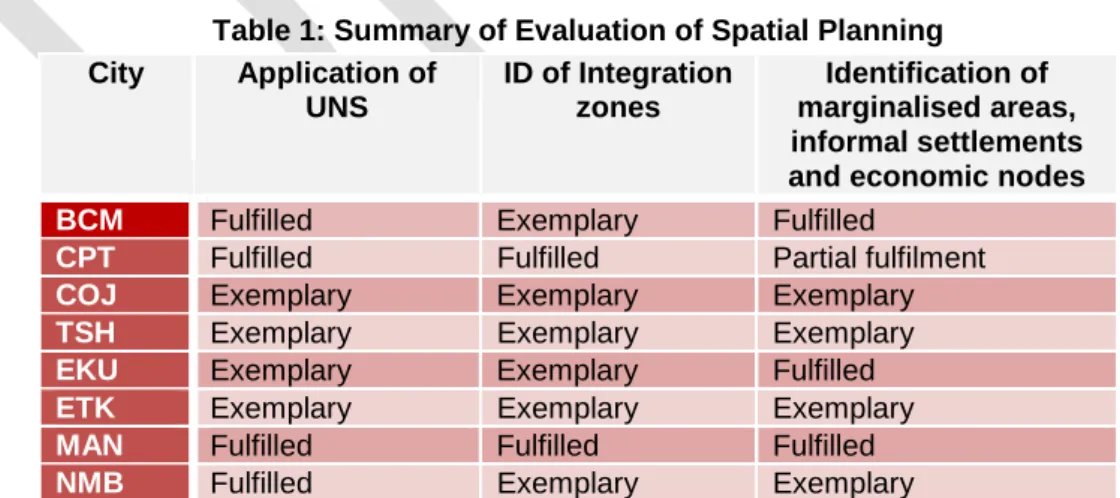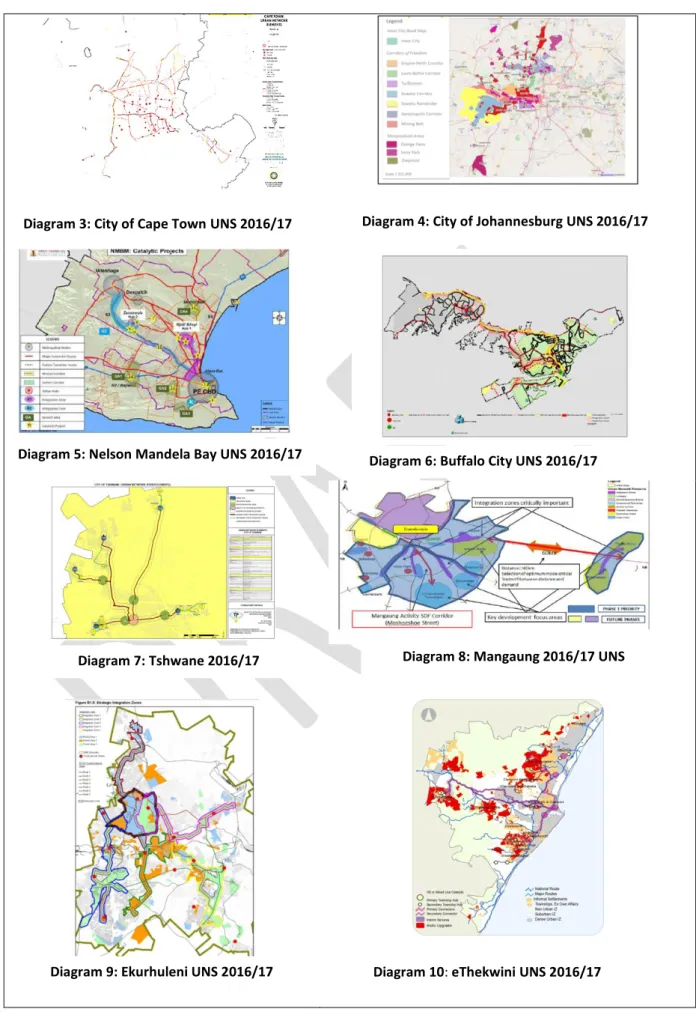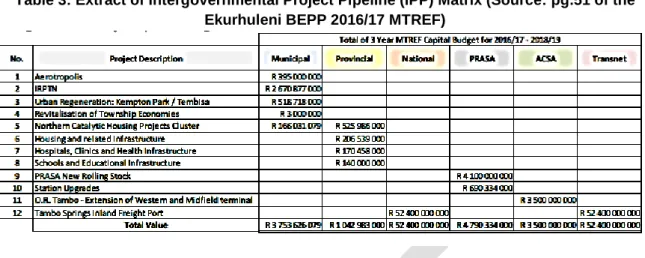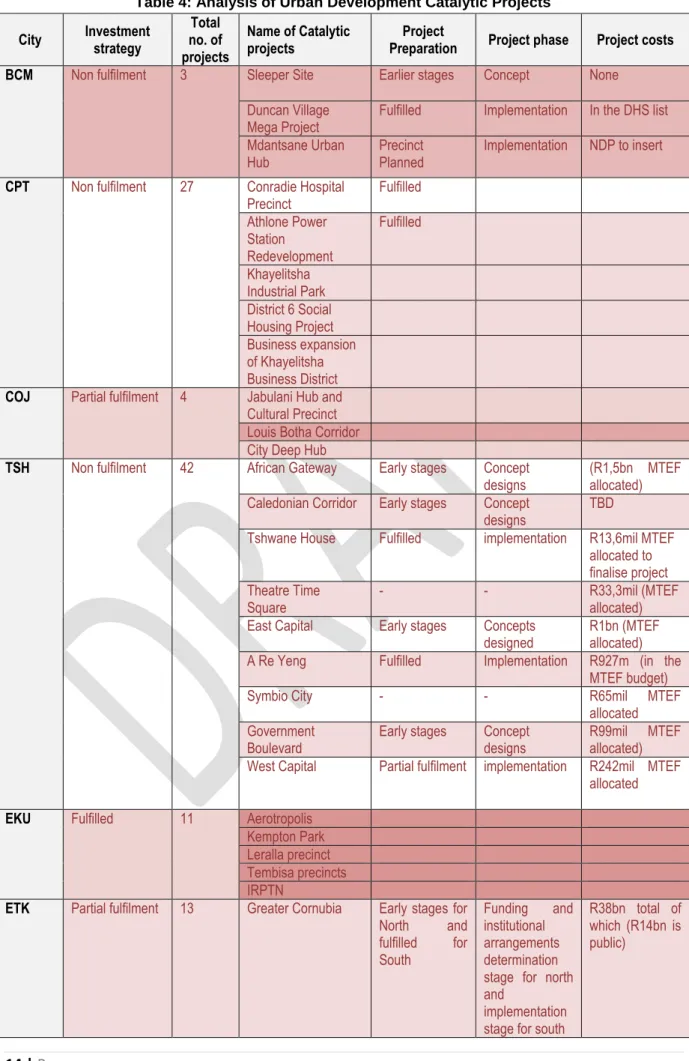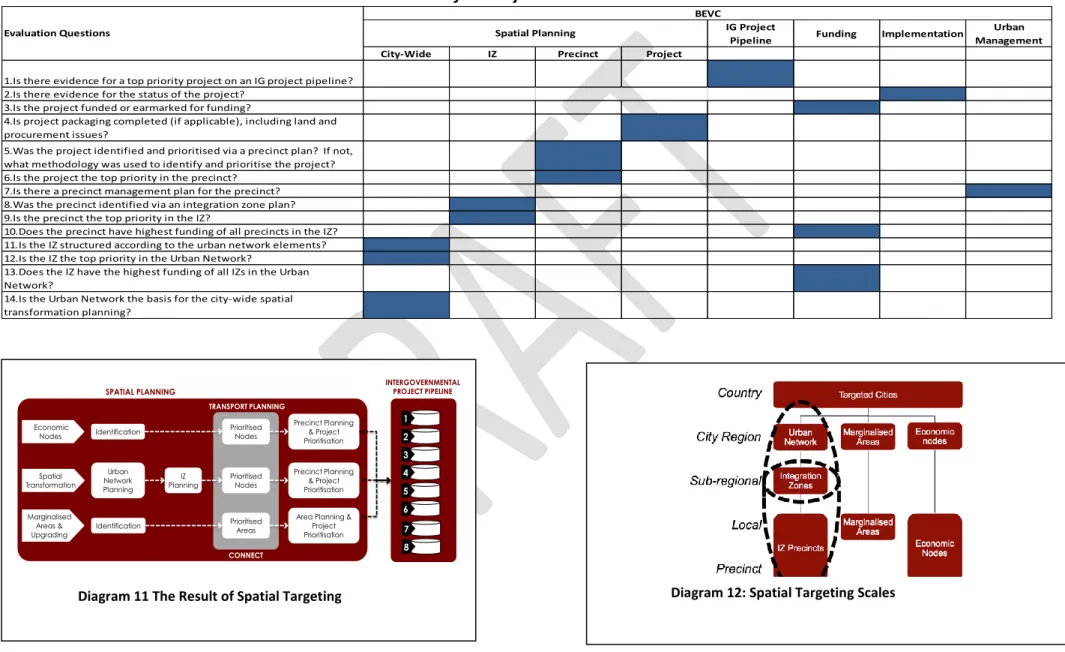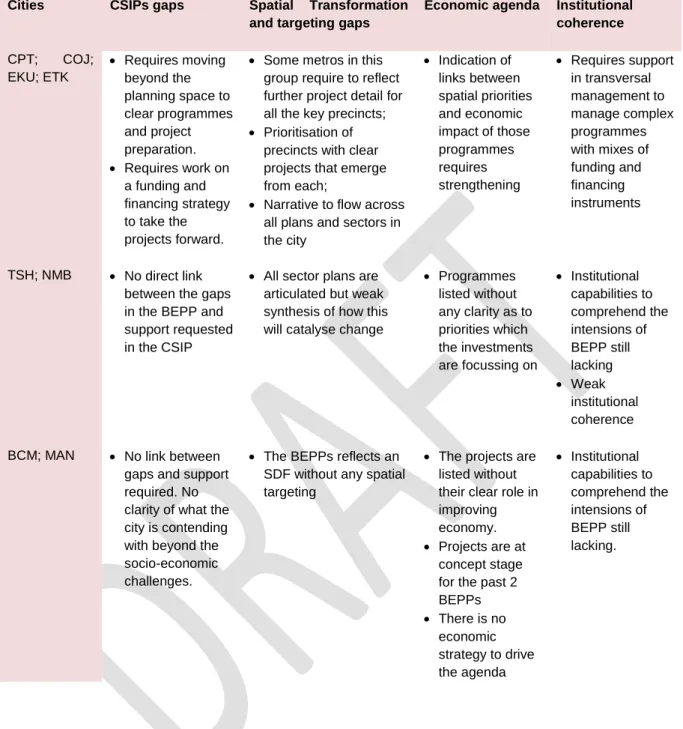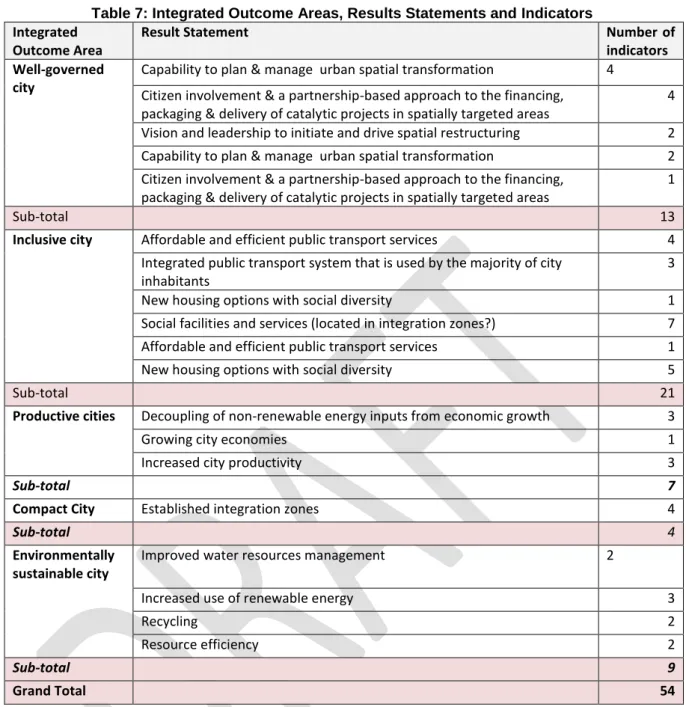Progress was noted with the design of the outcome indicators supported by a framework, principles and criteria for outcome indicators, and inclusion in the Council-approved BEPP for the 2016/17 MTREF. However, there were problems in the population of baseline data for most of the outcome indicators. In municipalities where gaps in the BEPPs were not related to support, only limited progress in planning and implementation was evidenced, while those that carefully structured their support requests made clear progress in the quality and detail of their plans.
The BEPP 2016/17 review took place in February and March 2016, aligned with the municipal budget review process. Mere performance in terms of results and failure to achieve planned results and impacts is not good enough, especially in the context of fiscal consolidation and the need for faster and inclusive growth. A key finding of this evaluation is that even though public transport and subsidized housing are critical elements of the government's agenda, more effort needs to be put into the planning and operation of these services in order not to negatively impact the long-term financial sustainability of municipalities.
Cities were asked to conduct a self-assessment of their BEPP as well as a peer review of at least one other city's BEPP; each city coordinator from the CSP team evaluated another city's BEPP and peer reviewed it; The Neighborhood Partnership Development Program made detailed assessments of spatial planning approaches and other activities in the Built Environment Value Chain (BEVC); the main departments of the sector (including Transport and Human Settlements) made evaluations of BEPPs; and has had specialist assessments such as from the DBSA. Much of the content of these Guidelines is informed by the assessment contained in this report.
Introduction
The purpose and objectives of BEPPs
Three key concepts are critical to this approach, which is encapsulated in the Built Environment Value Chain (BEVC), (i) Results-led planning; (ii) prioritization and preparation; and (iii) Progression. The performance of the built environment will be assessed through the reporting and evaluation of urban transformation results and indicators of impact. The BEPP is the plan and process informed by the Built Environment Value Chain (BEVC) as depicted in Diagram 2 below.
BEVC is an intergovernmental process or set of activities aimed at achieving the objectives of the built environment in cities. 3 3 Final Guidance on BEPPs in Folder 4: Supporting Documents for the Consolidated Assessment of BEPPs 2016/17 Diagram 1: Built Environment Value Chain (BEVC). The built environment value chain (BEVC) is an intergovernmental process or set of activities linked in a logical sequence that is targeted.
The introduction of BEPPs and experience to date indicate that a level of reform is required in relation to the planning approach (process and plans) as well as the implementation arrangements that deliver and manage infrastructure investment in the built environment. Moving through the BEVC activities is important to show the link between the activities and that the activities should result in tangible changes in the built environment that can be seen and felt by people.
Alignment of planning and budgeting frameworks
Mid-Year Budget and BEPP Reviews (MYBBR)
The purpose of the half-year budget review is to provide legislative oversight of spending midway through the financial year and thus be able to provide input into the budget adjustment. Seven of the eight metropolitan municipalities submitted their Draft BEPPs for the 2016/17 MTREF to National Treasury on 3 November 2015. The highlights of the 8 engagements were (1) the sessions on the country's economic outlook, (2) the Fiscal Sustainability of Public Transport/BRT; and (3) an assessment of city performance in terms of expenditure in terms of the national Department of Human Settlements (DHS) Medium Term Strategic Framework (MTSR) targets, particularly in respect of the upgrading of informal settlements.
The reality of operating the public transport systems, specifically the BRTs, has been one of higher than predicted operating costs, as well as lower revenues. As it stands, we have yet to fully utilize the potential of the industry to provide a public transport service. One key intent of the sessions was to highlight the need for cities to commit own resource funding to these systems given the reality of shortages.
The budget figures provided were often not realistic or based on long-term understanding of the economic realities of operating the systems. A number of cities have recognized the significant risk posed by the systems' operating costs and have embarked on cost-cutting and revenue-raising measures.
IDP-BEPP-Budget Alignment and Benchmarking
It was also clear that most metropolitan municipalities could not find a significant match between financial and non-financial performance information regarding Human Settlements expenditures and the targets – in some cases it was clear that the MTSF targets would not be met due to the shortage of provincial transfers being made to the metropolitan municipalities (e.g. eThekwini). Public transportation and housing programs must generate sufficient revenues to avoid draining financial resources, and planning for these programs must take into account increasingly limited financial and other resources. For example, a greater focus on upgrading informal settlements, affordable and social housing programs could have a more positive impact on city revenues than a focus on GNH/RDP housing that rarely contributes to rates and service revenues.
What would be more beneficial would be a stronger alignment of spatial planning with key public investments in transport and housing. The Consolidated Report on the 2016 Mid-Year Budget and BEPP Reviews and individual city reports are available on the National Treasury website.4.
Evaluation of the BEPP for the 2016/17 MTREF
General
Sector reviews of stakeholders were carried out by the relevant transport and human settlements sector departments and a specialist review was carried out by the DBSA on the financial closure aspect of BEPPs. The assessment of public transport stakeholders emphasized the need for public transport planning in BEPPs to play a much more decisive role through public transport's own planning tool, the Comprehensive Integrated Transport Plan (CITP). The assessment of the BEPPs also highlighted that the next round of BEPPs should again emphasize the need for better alignment between public transport networks and areas of prioritization and spatial targeting.
Furthermore, there is a greater need to test modal integration as it is key to creating sustainable and user-friendly public transport systems; it is necessary to ensure greater coordination between housing and the use of public transport. The CSP provided an assessment of the overall BEPP with particular reference to catalytic urban development projects and built environment outcome indicators. The main objectives of the DBSA evaluation were to (i) identify missing financial information (information that would attract financiers and private investors to invest in the catalytic project's petroleum);
The evaluation highlighted a number of shortcomings and inconsistencies in the BEPPs' various financial models and strategies. Identified sources of funding (grants, own resources, borrowing) and status of financial closure in this regard.
Strategic BEPP Priorities for the 2016/17 MTREF
- Spatial Planning, Intergovernmental Project Pipeline and Catalytic Projects
- Assessment of gaps in BEPPs
- Built Environment Outcome Indicators and Targets
The best example of completion of the spatial planning and targeting activity is the COJ. Cities do not pay sufficient attention to the pre-project and start-up stages of the project cycle. i). The current phase in the project cycle was not reflected for many of the projects.
Although the guidelines referred to the phases of the project cycle as reflected in the Cities Project Preparation Framework, this was not used. The evaluation highlighted the following shortcomings and inconsistencies in the various financial models and strategies of BEPPs. In each of the metros, there was an overall assessment of whether the CSIPs are responsive to the issues raised in the BEPP.
These projects will strengthen the spatial planning (by aligning the Transport Planning) and implementation (packaging of spatially targeted catalytic projects) of the BEPP. High-level institutional and political buy-in of the BEPP is required in these metros. Forty-two of the indicators refer to the city as a whole, with twelve specifically relevant to integration zones.
EMM has completed 3 indicators out of 30 expected to be filled (or partially filled in some cases).

Overall Evaluation Findings and Guideline Recommendations
There is no evidence of joint subway planning for the BEPP; it could simply be a fixed intention. Evidence of some level of cross-functional collaboration in the preparation of the BEPP. There is no evidence of a transition to an IZ approach in terms of the Guides.
No evidence of a Strategy for the Pri ori ti s ed ma rgi nl a i s ed a rea s. L2 pl us evidence of mostly public sector and some private sector investments Growth area Project preparation: projects. Some evidence of the essential policy and regulatory instruments is put in place.
L2 plus pruf fɔ wan lɔng tɛm ɔpreshɔnal faynans plan. No pruf nɔ de fɔ di land ɛn rel strateji dɛn we gɛt fɔ du wit di tɔp prayoritɛd prɔjek dɛn. No pruf nɔ de fɔ wan patikyula prokyumɛnt we fɔ di tɔp prayoritɛd prɔjek dɛn.
L3 pl us evidence of effectiveness generated in project impl ementa tio n. No evidence of required impl ementa ti on s tructures is put in place. Some evidence that it is necessary to implement structures is put in place.
T2 plus pruf fɔ rapid delivri fɔ prayoritɛd prɔjek dɛn Instityushɔnal arenjmɛnt: BEPP kɔmpɔnɛnt. L2 plus pruf fɔ rapid delivri fɔ prayoritɛd prɔjek dɛm. No pruf nɔ de fɔ se shift de na di dairekshɔn fɔ prɛsis manejmɛnt mɛtɔd wit di e s pa tial.
No evidence of precision management arrangements or entities being established. No evidence that the required cross-cutting implementation structures are being put in place. Some evidence of the necessary cross-cutting implementation structures being put in place.
No evidence of a consolidated link of the operating budget to the BEPP.
